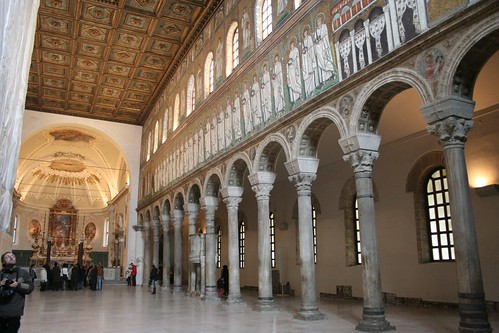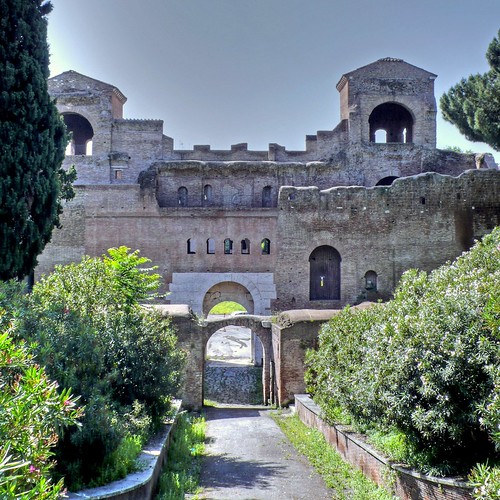OSTROGOTHIC KINGDOM
The Ostrogothic Kingdom established by the Ostrogoths in Italy and neighbouring areas lasted from 493 to 553. In Italy the Ostrogoths replaced Odoacer, the de facto ruler of Italy who had deposed the last emperor of the Western Roman Empire in 476. The Gothic kingdom reached its zenith under the rule of its first king, Theodoric the Great. Most of the social institutions in the late Western Roman Empire were preserved during his rule.
Starting in 535, the Eastern Roman Empire invaded Italy. The Ostrogothic ruler at that time, Witiges, could not defend successfully and was finally captured when the capital Ravenna fell. The Ostrogoths rallied around a new leader, Totila, and largely managed to reverse the conquest, but were eventually defeated. The last king of the Ostrogothic Kingdom was Teia.
The Ostrogoths
The Ostrogoths were the eastern branch of the Goths. They settled and established a powerful state in Dacia, but during the late 4th century, they came under the dominion of the Huns. After the collapse of the Hunnic empire in 454, large numbers of Ostrogoths were settled by Emperor Marcian in the Roman province of Pannonia as foederati. But in 460, during the reign of Leo I, because the payment of annual sums had ceased, they ravaged Illyricum. Peace was concluded in 461, whereby the young Theodoric Amal, son of Theodemir of the Amals, was sent as a hostage to Constantinople, where he received a Roman education. In previous years, a large number of Goths, first under Aspar and then under Theodoric Strabo, had entered service in the Roman army and were a significant political and military power in the court of Constantinople. The period 477-483 saw a complex three-way struggle among Theodoric the Amal, who had succeeded his father in 474, Theodoric Strabo, and the new Eastern Emperor Zeno. In this conflict, alliances shifted regularly, and large parts of the Balkans were devastated by it. In the end, after Strabo's death in 481, Zeno came to terms with Theodoric. Parts of Moesia and Dacia ripensis were ceded to the Goths, and Theodoric was named magister militum praesentalis and consul for 484. However, barely a year later, Theodoric and Zeno fell out, and again Theodoric's Goths ravaged Thrace. It was then that the thought occurred to Zeno and his advisors to kill two birds with one stone, and direct Theodoric against another troublesome neighbour of the Empire - the Italian kingdom of Odoacer.
Odoacer's kingdom
In 476, Odoacer, a Germanic magister militum, deposed the Western Emperor Romulus Augustulus and declared himself rex Italiae ("King of Italy"), while still nominally remaining under Imperial suzerainty. This fact was recognized by Zeno in 477, when he appointed Odoacer to the rank of patrician. Odoacer retained the Roman administrative system, cooperated actively with the Roman Senate, and his rule was efficient and successful. He evicted the Vandals from Sicily in 477, and in 480 he conquered Dalmatia after the murder of Julius Nepos.
 The conquest of Italy by the Goths
The conquest of Italy by the GothsAn agreement was reached between Zeno and Theodoric, stipulating that Theodoric, if victorious, was to rule in Italy as the emperor's representative. Theodoric with his people set out from Moesia in the autumn of 488, passed through Dalmatia and crossed the Julian Alps into Italy in late August 489. The first confrontation with the army of Odoacer was at the river Isonzo (the battle of Isonzo) on August 28. Odoacer was defeated and withdrew towards Verona, where a month later another battle was fought, resulting in a bloody, but crushing, Gothic victory. Odoacer fled to his capital at Ravenna, while the larger part of his army under Tufa surrendered to the Goths. Theodoric then sent Tufa and his men against Odoacer, but he changed his allegiance again and returned to Odoacer. In 490, Odoacer was thus able to campaign against Theodoric, take Milan and Cremona and besiege the main Gothic base at Ticinum (Pavia). At that point, however, the Visigoths intervened, the siege of Ticinum was lifted, and Odoacer decisively defeated at the river Adda on 11 August 490. Odoacer fled again to Ravenna, while the Senate and many Italian cities declared themselves for Theodoric.
The Goths now turned to besiege Ravenna, but since they lacked a fleet and the city could be resupplied by sea, the siege could be endured almost indefinitely, despite privations. It was not until 492 that Theodoric was able to procure a fleet and capture Ravenna's harbours, thus entirely cutting off communication with the outside world. The effects of this appeared six months later, when, with the mediation of the city's bishop, negotiations started between the two parties. An agreement was reached on 25 February 493, whereby the two should divide Italy between them. A banquet was organised in order to celebrate this treaty. It was at this banquet, on March 15, that Theodoric, after making a toast, killed Odoacer with his own hands. A general massacre of Odoacer's soldiers and supporters followed. Theodoric and his Goths were now masters of Italy.
The reign of Theodoric the Great
"... Theoderic was a man of great distinction and of good-will towards all men, and he ruled for thirty-three years. In his times Italy for thirty years enjoyed such good fortune that his successors also inherited peace. For whatever he did was good. He so governed two races at the same time, Romans and Goths, that although he himself was of the Arian sect, he nevertheless made no assault on the Catholic religion; he gave games in the circus and the amphitheatre, so that even by the Romans he was called a Trajan or a Valentinian, whose times he took as a model; and by the Goths, because of his edict, in which he established justice, he was judged to be in all respects their best king." --Anonymus Valesianus, Excerpta II 59-60
 The nature of Theodoric's rule
The nature of Theodoric's ruleLike Odoacer, Theodoric was ostensibly a patricius and subject of the emperor in Constantinople, acting as his viceroy for Italy, a position recognized by the new Emperor Anastasius in 497. At the same time, he was the king of his own people, who were not Roman citizens. In reality, he acted as an independent ruler, although unlike Odoacer, he meticulously preserved the outward forms of his subordinate position. The administrative machinery of Odoacer's kingdom, in essence that of the former Empire, was retained and continued to be staffed exclusively by Romans, such as the articulate and literate Cassiodorus. The Senate continued to function normally and was consulted on civil appointments, and the laws of the Empire were still recognized as ruling the Roman population, though Goths were ruled under their own traditional laws. Indeed, as a subordinate ruler, Theodoric did not possess the right to issue his own laws (leges) in the system of Roman law, but merely edicts (edicta), or clarifications on certain details. The continuity in administration is illustrated by the fact that several senior ministers of Odoacer, like Liberius and Cassiodorus the Elder, were retained in the new kingdom's top positions. The close cooperation between Theodoric and the Roman elite began to break down in later years, especially after the healing of the ecclesiastical rift between Rome and Constantinople, as leading senators conspired with the Emperor. This resulted in the arrest and execution of the magister officiorum Boethius and his father-in-law, Symmachus, in 524.
On the other hand, the army and all military offices remained the exclusive preserve of the Goths. The Goths were settled mostly in northern Italy, and kept themselves largely apart from the Roman population, a tendency reinforced by their different faiths: the Goths were mostly Arians, while the people they ruled over were following Chalcedonian Christianity. Nevertheless, and unlike the Visigoths or the Vandals, there was considerable religious tolerance, which was also extended towards Jews. Theodoric's view was clearly expressed in his letters to the Jews of Genoa: "The true mark of civilitas is the observance of law. It is this which makes life in communities possible, and which separates man from the brutes. We therefore gladly accede to your request that all the privileges which the foresight of antiquity conferred upon the Jewish customs shall be renewed to you..." and "We cannot order a religion, because no one can be forced to believe against his will."
Architecture
Because of the kingdom's short history, no fusion of the two peoples and their art was achieved. However, under the patronage of Theodoric and Amalasuntha, large-scale restoration of ancient Roman buildings was undertaken, and the tradition of Roman civic architecture continued. In Ravenna, new churches and monumental buildings were erected, several of which survive. The Basilica of Sant'Apollinare Nuovo, its baptistry, and the Archiepiscopal Chapel follow the typical late Roman architectural and decorative motifs, but the Mausoleum of Theodoric displays purely Gothic elements, such as its construction not from the usual brick, but of massive slabs of Istrian limestone, or the 300-ton single-piece roof stone.
 Literature
LiteratureAll of the surviving literature written in the Ostrogothic kingdom is in Latin, though some older works were copied in Greek and Gothic (e.g. the Codex Argenteus), and the literature is solidly in the Greco-Roman tradition. Cassiodorus, hailing from a distinguished background, and himself entrusted with high offices (consul and magister officiorum) represents the Roman ruling class. Like many others of his background, he served Theodoric and his heirs loyally and well, something expressed in the writings of the period. In his Chronica, used later by Jordanes in his Getica, as well as in the various panegyrics written by him and other prominent Romans of the time for the Gothic kings, Roman literary and historical tradition is put in the service of their Gothic overlords. His privileged position enabled him to compile the Variae Epistolae, a collection of state correspondence, which gives great insight into the inner workings of the Gothic state. Boethius is another prominent figure of the period. Well-educated and also from a distinguished family, he wrote works on mathematics, music and philosophy. His most famous work, Consolatio philosophiae, was written while imprisoned on charges of treason.
**************************************************
Theodoric the Great
Theodoric is considered to be one of the greatest Germanic kings in history. He was not only a warrior king, but showed great statesmanship and the personality to bring together hostile groups. We don't really have time to go into his life in depth here now, but can get back to him at a future time.
One more time, Theoderic the Great's biography from Wikipedia
**************************************************
The Ostrogothic period was a more complex one than the Lombardic period, mainly because Rome was still strong when the Goths began to flex their muscles in the Balkans. In fact, Byzantine Rome used the Lombards to break up the Gothic power base in Ravenna. In some ways, from our perspective today, the Lombards and the Ostrogoths could be considered under the umbrella of a larger Germanic period in Northern Italian history.
Heritage History Website (info on the Goths and a lot of other subjects)
'The Origin and Deed of the Goths' (by Jordanes)
Jordanes biography (Wikipedia)

No comments:
Post a Comment